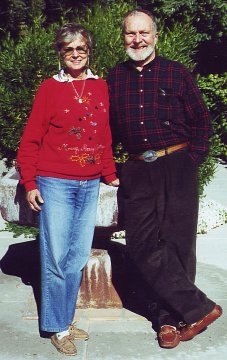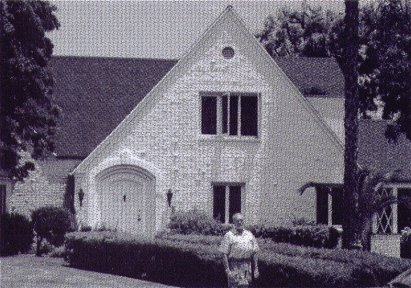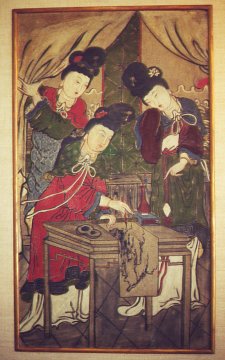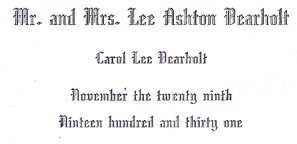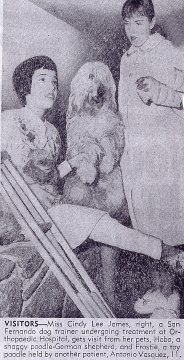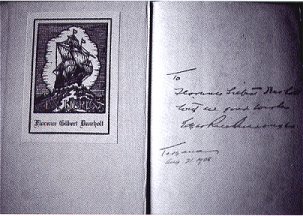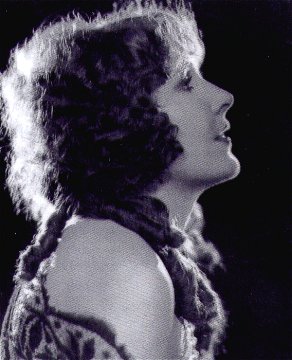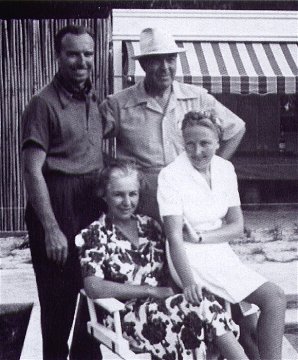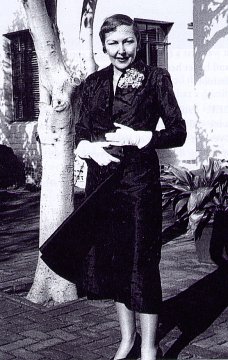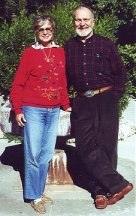 In August of
2001 I received a phone call from Lee Chase, who had just returned from
Los Angeles from Sedona, Arizona where his sister, Caryl Lee, had recently
passed away. Lee had brought home with him a scrapbook containing photographs
and mementos that had belonged to his mother, Florence
Gilbert -- silent film actress and second wife of Edgar Rice Burroughs.
In August of
2001 I received a phone call from Lee Chase, who had just returned from
Los Angeles from Sedona, Arizona where his sister, Caryl Lee, had recently
passed away. Lee had brought home with him a scrapbook containing photographs
and mementos that had belonged to his mother, Florence
Gilbert -- silent film actress and second wife of Edgar Rice Burroughs.
Lee also brought home a box filled with Edgar Rice Burroughs's books
that had belonged to his mother. The books had been gifts from Ed to Florence
over a period of more than a decade. Almost all of the books were adorned
with Florence Gilbert's bookplates inside the front covers. Many of them
also contained personal inscriptions from Ed Burroughs to Florence.
Lee invited me to come and view this treasure trove, which he said had
jogged his memory regarding the years he had lived with ERB as his stepson
(1935-1940). After examining the scrapbook assortment of Ed's hardcover
novels, we agree that a follow-up interview for The
Burroughs Bulletin would be in order. To further jog Lee's memory,
I contacted George McWhorter to see whether copies of the original Irwin
Porges taped interviews of Florence Gilbert, Caryl Lee and Lee Chase, and
Ed
Gilbert from the 1960s were available. They were, and George had them
transferred to CDs which he forwarded to us. (Thank you, George!)

FRANK: Thank you for inviting me back. It was a year ago today (July
10, 2001) when we conducted your first
interview for The Burroughs Bulletin.
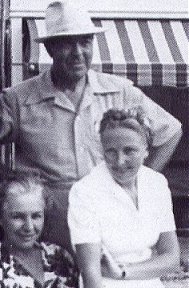 LEE:
Yes, I enjoyed that. And you're welcome to ask whatever else might come
to mind concerning mother and Ebbie and I'll try to be of help.
LEE:
Yes, I enjoyed that. And you're welcome to ask whatever else might come
to mind concerning mother and Ebbie and I'll try to be of help.
FRANK: I was listening to the interview that Irwin Porges and his wife
Cele conducted with your mother in May of 1969. The Porges asked dozens
of good questions and your mother's responses are quite enlightening. However,
one question I kept hoping would come up in that interview, but never did,
is whether your mother ever read any of Edgar Rice Burroughs's books; and
if so, what she thought of them?
LEE: Well, yes, she did. She was a very, very avid reader her whole
life. Whether it was a book-of-the-month club or something from the local
lending library, she was constantly finishing one book and picking up the
next. She always had a book. She read Ebbie's stuff -- definitely.
FRANK: Did she ever mention her impressions of any of his stories.
LEE: She liked Ebbie's books. But she wondered at one time how he could
have written so many stories set in Africa without ever having been there.
She could understand how he'd never been to Mars. He'd never been anywhere,
never traveled, except of course, through the western United States.
FRANK: As Irwin pointed out in his 1969 interview, Ed did get to Idaho
when he was young. That got a big laugh on his tape.
LEE: Yes, and he was down in Arizona in the army, places like that.
FRANK: Many of his travels were made with your mother Florence while
they were married. And, of course, ERB saw much of the Western Pacific
as a war correspondent
during World War II.
LEE: I remember mother and Ebbie drove the new 1937 Packard to New York
once, then shipped it home through the Panama Canal on a ship called the
"Empress of Japan." There's a picture of Ebbie standing with the Packard
on a pier with the ship in the background. I remember mother describing
a couple of navy fliers that buzzed the ship and one of them hit the water
and that was the end of it. The only thing that came up to the surface,
she said, was one tire. That happened on Gatun Lake, the big lake between
the two locks of the canal.
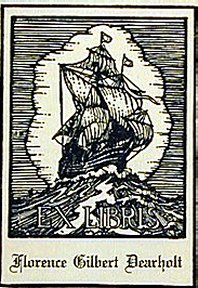
 FRANK:
Looking through this collection of ERB's books that belonged to your mother,
I count nine that are inscribed by Ed. And I notice that she had two different
bookplates. The earlier one (with a sailing ship) reads: "Ex Libris Florence
Gilbert Dearholt." The later one (featuring a Hawaiian scene) reads: "Ex
Libris Florence Gilbert Burroughs." The fact that your mother used personalized
bookplates would seem to indicate that she loved books.
FRANK:
Looking through this collection of ERB's books that belonged to your mother,
I count nine that are inscribed by Ed. And I notice that she had two different
bookplates. The earlier one (with a sailing ship) reads: "Ex Libris Florence
Gilbert Dearholt." The later one (featuring a Hawaiian scene) reads: "Ex
Libris Florence Gilbert Burroughs." The fact that your mother used personalized
bookplates would seem to indicate that she loved books.
LEE: Oh yes. And I'm sure she read everything she put a bookplate in.
I wouldn't be surprised if she read all of Ebbie's stuff -- particularly
the Tarzan books. I know she read those. She was always interested in whatever
he was doing, and I would assume she read everyone of them. She really
was an avid reader.
FRANK: In her interview with Irwin and Cele Porges your mother reveals
that ERB claimed to have fallen in love with her "almost at first
sight." That's a highly romantic concept. But then, ERB revealed
his romantic nature in almost all of his fiction.
LEE: True. I don't know exactly when they first met, probably in 1927.
But mother was unaware of Ebbie having any special feelings for her then.
FRANK: These signed books span a period from 1928 through 1939. There
is a first edition of Tarzan,
Lord of the Jungle containing the Florence Gilbert Dearholt bookplate.
The flyleaf inscription reads: "To Florence with every good wish, Edgar
Rice Burroughs, Tarzana, Oct. 21, 1928."
LEE: That was one of the earlier inscriptions, which were more formal.
FRANK: Here is a first edition of Jungle
Girl. It contains both of your mother's bookplates. The later plate,
with the Diamond Head scene, has been placed over the earlier one. The
inscription reads: "To Florence Dearholt with best wishes, Edgar Rice,
May 6, 1932." An interesting item, though the book shows water damage.
LEE: A lot of the books -- a lot of everything -- was stored out at
the ranch when we went to Hawaii. The building leaked when it rained and
a lot of the books and furniture were damaged.
FRANK: Irwin Porges asked your mother whether ERB ever discussed
any of his stories with her, and I assume he meant while he was writing
them. The response was negative. Yet Ed gave Florence many copies of his
books. Here is a first edition of Swords
of Mars, an intriguing title in that it contains a secret message:
"To Florence with all my love, Ed," spelled out by stringing together the
first letter of the first word in each chapter. The flyleaf inscription
reads: "To Florence, all my love always, Ed, Tarzana Jan 21, 1936.
LEE: Mother was very fond of that book. She found the hidden message
to be an extremely romantic gesture. There was even a specially bound,
light-tan pigskin covered copy that Ebbie gave to her. It was the first
bound copy that came from the printer which Ebbie must have had re-covered.
It's not around anymore and I don't know what became of it. It wasn't with
my sister's things, and I don't believe Uncle Eddie had it either.
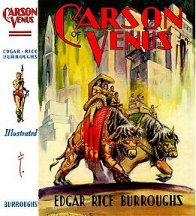 FRANK:
Let's hope it will surface someday! Here's a nice first edition of Carson
of Venus with dust jacket. There is a plate inside the front cover
that states: "This Book is the first bound copy." Beneath it is the Florence
Gilbert Burroughs bookplate. The inscription reads: "Florence, with
love, Ed, Jan 13, 1939."
FRANK:
Let's hope it will surface someday! Here's a nice first edition of Carson
of Venus with dust jacket. There is a plate inside the front cover
that states: "This Book is the first bound copy." Beneath it is the Florence
Gilbert Burroughs bookplate. The inscription reads: "Florence, with
love, Ed, Jan 13, 1939."
LEE: That would be one of the later books Ebbie inscribed to mother.
FRANK: You mentioned on the phone that you recently re-read all these
books.
LEE: Yes, I did. First of all, I went through all the pocket books.
Then I started through these. They were just as interesting and fascinating
as they were the first time around. I started reading Burroughs's books
when we were living in Kailua, Hawaii. I'd been grumbling about having
nothing to read and Ebbie said: "Maybe Lee would enjoy some of my books."
And he gave me some of his books to read. I was fascinated with them and
read everything he ever wrote.
FRANK: Did you ever discuss any of his stories with him?
LEE: No, never did.
FRANK: Your mother mentions in the Porges interview that ERB could be
rather jealous and possessive of her. She recalled an incident that occurred
before they were married when she kissed an old friend of hers named Paul
Speyer. Of course, it was just a friendly kiss but apparently irked Ed
and he let her know about it later in some negative fashion.
LEE: Paul and Esther Speyer and their son David were old friends of
the family. They used to live over on Cherokee, near here. I can remember
spending the night there several times.
FRANK: Apparently the next day Ed sent Florence some American Beauty
roses.
LEE: Felt guilty, probably. Apologizing for his behavior. I can see
that.
FRANK: Your mother also relates a story about a party at the Sunset
Plaza apartments where a woman named Jessie Knott came up to ERB and
kissed him and was gooing over him. He was rather repulsed by that. According
to Florence, Ed felt that the woman had somehow made a fool of him and
he "never wished to speak with her again." But when she phoned the Burroughs
residence the next day, Ed took the telephone from Florence's hand and
did speak to her again in a friendly manner.
LEE: Yeah, he was not a huggy kissy person at all. As I remember, he
was quite standoffish. He'd shake hands with a guy, but quickly, and that
was the end of that. And with the women, he didn't give them hugs, he just
didn't do it. He was very personable when speaking, either on the phone
or in person. But he might have a little different opinion of you later,
or before. But I don't think that I ever heard him angry with or insult
anyone face-to-face.
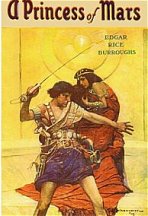 FRANK:
Getting back to the books, here is a green cloth Grosset & Dunlap edition
of A Princess of Mars
that dates from 1926 or 1927. It contains your mother's bookplate and two
inscriptions from ERB. The flyleaf inscription reads: "To Florence Gilbert
Dearholt with all good wishes, Edgar Rice Burroughs, Tarzana August
21, 1928." I think that is the earliest inscription here. And on the
dedication page we find: "Florence -- This is the first story that I
ever wrote and, I believe, one of the best -- or, it might be better to
say, less worse. Ed."
FRANK:
Getting back to the books, here is a green cloth Grosset & Dunlap edition
of A Princess of Mars
that dates from 1926 or 1927. It contains your mother's bookplate and two
inscriptions from ERB. The flyleaf inscription reads: "To Florence Gilbert
Dearholt with all good wishes, Edgar Rice Burroughs, Tarzana August
21, 1928." I think that is the earliest inscription here. And on the
dedication page we find: "Florence -- This is the first story that I
ever wrote and, I believe, one of the best -- or, it might be better to
say, less worse. Ed."
LEE: Yes, that sounds like him.
FRANK: So he feels that A Princess of Mars is one of his
best stories. Yet he also seems sensitive to the fact that literary critics
of his time never seemed to think very highly of his work.
LEE: He would make jokes about himself. He was self-deprecating -- he
could kid other people but could also kid himself.
FRANK: When Irwin Porges asked your mother what she found most appealing
about ERB she replied: "What I liked about him most of all was his personality,
his wonderful sense of humor which was self-derogatory."
LEE: Yes, I can certainly remember his special sense of humor.
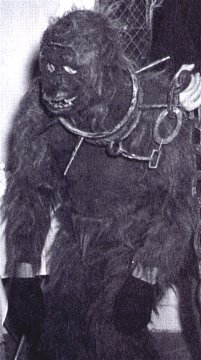 FRANK:
That brings us to a very fascinating photograph from your mother's scrapbook
which shows Florence and Ed, presumably, at a costume party. ERB is wearing
an ape suit or a gorilla suit. There is a chain around his neck that is
being held by a gentleman in a high hat who is posing as Ed's "keeper."
Can you tell us the story behind this photo?
FRANK:
That brings us to a very fascinating photograph from your mother's scrapbook
which shows Florence and Ed, presumably, at a costume party. ERB is wearing
an ape suit or a gorilla suit. There is a chain around his neck that is
being held by a gentleman in a high hat who is posing as Ed's "keeper."
Can you tell us the story behind this photo?
LEE: Sure. Mother and Ebbie had evidently been invited to a costume
party. I don't think either of them cared all that much for costume parties,
but that makes it even more interesting that they went to such great lengths
for this one. Several days before the party a rumor spread around the house
-- that would be 716 N. Rexford -- that a gorilla had escaped from the
zoo. My sister and I were kids and, of course, our curiosity was aroused.
I recall Ebbie telling us: "That gorilla has been seen in the neighborhood,
so you kids watch out!" The servants (we had a butler, chauffeur and cook)
were not in on it either. So hints were dropped for several days about
this escaped gorilla and everyone was on the lookout. Then one day mother
said: "Oh my God, look out in the backyard!" We had a rather deep backyard,
as they have in Beverly Hills, and way out in he back was this gorilla.
I think my heart dropped right into my shoes. My sister and I ran out of
the house. The butler ran out with a hatchet that he'd found -- he was
going to protect the family. I looked at mother and she was giggling and
laughing. My sister caught on before I did and ran over and jumped in the
gorilla's arms. Then Ebbie took off the head of the costume and there he
was! He just got the biggest kick out of that.
FRANK: What a classic practical joke!
LEE: Oh yes, Ebbie loved it. He just pulled it on the immediate household.
Then they went to the party and that's were the photograph was taken. The
ape/gorilla suit might have been something he found on a movie set and
decided to borrow. The chain, of course, wasn't real; it was made of plastic.
Later I figured out that Ebbie really enjoyed that sort of thing.
FRANK: Can you identify the other two people in the photo?
LEE: No, I have no idea who they are.
FRANK: That's a great story and I love the photograph. If ERB possessed
an alter ego in the animal kingdom my guess is that it was probably simian.
Since we can't see Ed's face, you are probably the only person alive who
can positively identify that individual in the ape costume as being Edgar
Rice Burroughs.
LEE: Well, it definitely was -- no one else would do it. It definitely
was. (Laughter.)
FRANK: Looking at this photograph of ERB with the 1937 Packard on the
pier. I'm struck by how proud and happy he appears.
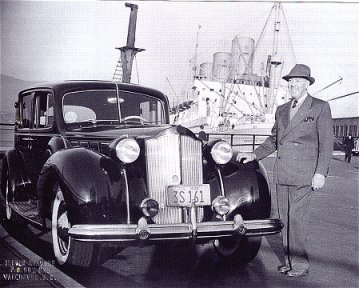
ERB and his 1937 Packard in Vancouver, B.C., 1938
LEE: That's pretty much how I remember him and he certainly loved automobiles.
I notice that there is a photographer's stamp on the corner of the picture
that indicates it was taken in Vancouver, British Columbia. It looks more
like Vancouver than Los Angeles; Ebbie has a sweater and a jacket on. So
I think the "Empress of Japan" docked in Vancouver and mother and Ebbie
drove home down the coast in the packard.
FRANK: Your mother mentioned that she didn't think Ed was all that great
of a driver.
LEE: I think he thought he was. I remember once when we were on the
way to Palm Springs on the old road and Ebbie got a speeding ticket. A
motorcycle officer pulled him over (after a brief chase) and said something
to the effect of: "Where do you think you're going, to a fire?" Ebbie was
always a fast driver but didn't pay a lot of attention to what was going
on around him.
FRANK: Did Ed have to pay the speeding ticket, I wonder?
LEE: I assume he did; he got it.
FRANK: Here is another great photograph. It shows Ed and Florence with
Tarzan actor Glenn Morris and his new bride, all with Hawaiian leis around
their necks, possibly arriving in Hawaii?
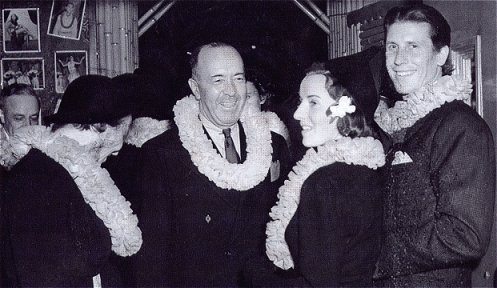
ERB and Glenn Morris with their wives in Hawaii, 1938
LEE: It looks awfully formal for an arrival or departure; everyone is
very formally dressed. Also, the leis don't look like real flowers, they
appear to be crepe paper. When you arrive or leave Hawaii they load you
up with dozens of leis and they're all real flowers. So my guess is that
it's some kind of reception or party. It's a bit of a mystery. I would
just say it's Hawaii circa 1938.
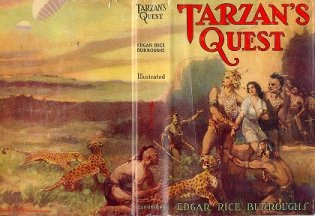 FRANK: Let's
look at a few more signed books. Here is a first edition with dust jacket
of Tarzan's Quest.
The inscription on the front flyleaf reads: "To Florence with all my
love, Ed, Tarzana, August 24, 1936."
FRANK: Let's
look at a few more signed books. Here is a first edition with dust jacket
of Tarzan's Quest.
The inscription on the front flyleaf reads: "To Florence with all my
love, Ed, Tarzana, August 24, 1936."
LEE: The inscriptions change from "best wishes" and things to "love"
after they were married.
FRANK: Ed was very tactful with his inscriptions to Florence before
they were married, although he and Ashton Dearholt were always friends.
LEE: Oh yes, very good friends, even afterward.
FRANK: Your mother mentioned in the Porges interview that even though
Ed had a jealous streak, he was never, ever jealous of your father Ashton
Dearholt.
LEE: Well, Ashton had moved on to a different life, you know, and obviously
to a different woman. So I don't think that Ebbie felt that there was any
threat there.
FRANK: Here is a first edition of Tarzan
the Magnificent with dust jacket. There is a plate inside the front
cover that states: "This Book is the first bound copy." The flyleaf
inscription reads: To Florence with love, Ed, Sept. 1,1939."

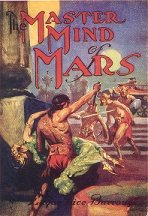
LEE: That would have been Ebbie's 64th birthday.
FRANK: The only foreign book in the lot is a British first edition with
dust jacket of The Mastermind
of Mars The book has a publisher's plate affixed to the front flyleaf
that states: "With the Compliments of Methuen & Co. Ltd. These copies
are for personal use, and should be shown only to members of the press
before the day of publication, which is 28th September 1939." Beneath it
is ERB's inscription: "To Florence with love, Ed, Tarzana, Oct. 7, 1939."
LEE: That would have been an advance copy sent to Ebbie by the publisher.
FRANK: You also have a unique book which contains two original poems
by Ed along with accompanying water color illustrations. It's a blue cloth
hardcover note book with blank pages that Ed apparently filled in while
he and your mother were on vacation. The two poems are titled, "The
Ballad of the B's" and "It's
Ants." Porges described this book and printed the two poems in
Chapter 23 of his 1975 biography Edgar Rice Burroughs: The Man Who Created
Tarzan. But no one outside of your family and the Porges have ever
actually seen the two poems in their original state, printed out in ERB's
hand with the beautiful, original water colors.
LEE: That book was created by Ebbie while he and mother were on a car
trip out in the desert in 1937. I think they were going to Las Vegas by
way of Kingman, Arizona. Auto-gypsying, so to speak I believe the car broke
down at one point. One of the water colors shows the Cord automobile being
pushed by hand along a narrow mountain road. I remember Ebbie making a
lot of little pen drawings, sketches and water colors that I thought were
quite good. He usually had some amusing verse to go along with them.
FRANK: Someday, perhaps, we can publish a limited facsimile of this
rare book for the fans.
LEE: Sure, if it's something they would be interested in. I don't see
why not.
FRANK: It was your sister, Caryl Lee, who mentioned something to Irwin
and Cele Porges about Johnny Weissmuller teaching you both how to swim
at the Sunset Plaza apartments.
LEE: I don't recall that happening, but it's certainly possible that
he may have dropped by one day when I wasn't around and shown my sister
a swimming stroke or two. We always had a pool and we were both water rats
from the very start.
FRANK: Are there any anecdotes you would like to share with us today?
LEE: Well, one time when we were living in Kailua, Ebbie found a bottle
with a note inside of it that had washed up on the beach in front of the
house. The note had been sent by some fisherman from one of the other Hawaiian
islands. Apparently he was rather lonely or bored and just wanted to see
where his note might go. He must have included return address, because
Ebbie sent the man a note back telling him where the bottle had been found.
He also sent along an autographed copy of one of his books. I thought that
was interesting.
FRANK A message found in a bottle. A fisherman's fantasy realized courtesy
of Edgar Rice Burroughs. On that note we'll have to leave it until next
time. Thank you again, Lee Chase!
LEE: You're entirely welcome.


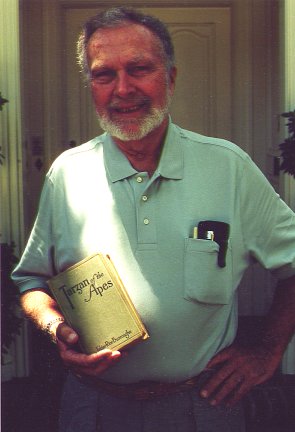
 In August of
2001 I received a phone call from Lee Chase, who had just returned from
Los Angeles from Sedona, Arizona where his sister, Caryl Lee, had recently
passed away. Lee had brought home with him a scrapbook containing photographs
and mementos that had belonged to his mother,
In August of
2001 I received a phone call from Lee Chase, who had just returned from
Los Angeles from Sedona, Arizona where his sister, Caryl Lee, had recently
passed away. Lee had brought home with him a scrapbook containing photographs
and mementos that had belonged to his mother, 

 FRANK:
Looking through this collection of ERB's books that belonged to your mother,
I count nine that are inscribed by Ed. And I notice that she had two different
bookplates. The earlier one (with a sailing ship) reads: "Ex Libris Florence
Gilbert Dearholt." The later one (featuring a Hawaiian scene) reads: "Ex
Libris Florence Gilbert Burroughs." The fact that your mother used personalized
bookplates would seem to indicate that she loved books.
FRANK:
Looking through this collection of ERB's books that belonged to your mother,
I count nine that are inscribed by Ed. And I notice that she had two different
bookplates. The earlier one (with a sailing ship) reads: "Ex Libris Florence
Gilbert Dearholt." The later one (featuring a Hawaiian scene) reads: "Ex
Libris Florence Gilbert Burroughs." The fact that your mother used personalized
bookplates would seem to indicate that she loved books.
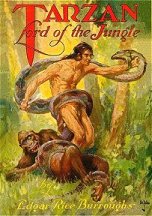
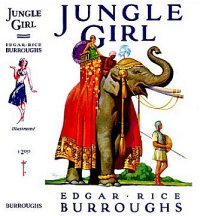
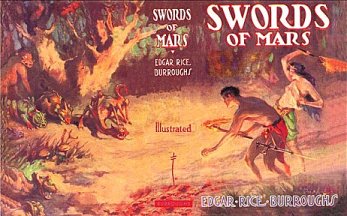





 FRANK: Let's
look at a few more signed books. Here is a first edition with dust jacket
of
FRANK: Let's
look at a few more signed books. Here is a first edition with dust jacket
of 


